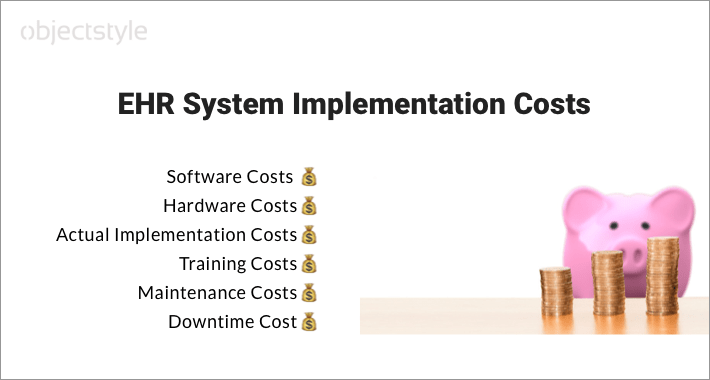
The implementation of electronic health record (EHR) systems has the potential to greatly improve productivity and quality of patient care in healthcare environments, providing numerous clinical benefits for patients and healthcare providers alike.
According to studies, between 78% and 85% of physicians using EHR systems report better overall patient care after EHR implementation, citing improvements in several key areas, including patient data accessibility, medical error reduction, lab test ordering, and patient communication.
While implementing EHR comes along with its own unique set of challenges, the benefits it can provide make it a worthwhile investment for healthcare organizations looking to upgrade the quality of their care and boost the productivity of their teams through digital transformation.
What Is EHR Implementation?
Electronic health records are a type of medical data storage solution aimed at optimizing a healthcare organization’s workflows.
EHR implementation involves planning, building, and integrating an electronic health record system or component into a healthcare organization’s IT infrastructure.
These EHR solutions are used by healthcare providers to securely document, store, access, and share patient medical history and information, ultimately improving the quality of care the organization is able to provide, as well as providing additional benefits.
Benefits of EHR Implementation

✅ Improved Patient Care
Physicians and other healthcare organization employees can use EHR solutions to boost their logistical productivity and efficiency, resulting in better patient care. By giving healthcare providers on-demand access to comprehensive and up-to-date patient information, these solutions facilitate decision-making and care coordination, contributing to the effectiveness of treatments and improving patient satisfaction.
✅ Data Security and Compliance
EHR system implementation significantly increases data security and compliance, providing greater control over how patient data is stored and who can access it. Cybersecurity solutions, such as encryption, protect against data breaches, while backup and recovery solutions protect against data loss. Additionally, EHR solutions are often designed to bring healthcare IT systems into compliance with specific healthcare industry regulations, such as HIPAA.
✅ Improved Efficiency and Coordination
By providing centralized access to data, EHR system implementation results in improved efficiency and coordination within healthcare organizations. EHR solutions facilitate communication and coordination between different healthcare organizations, departments, and systems, ensuring patient health records are available when and where they’re needed.
✅ Cost Savings
There are potentially significant long-term cost savings associated with successful EHR implementation. These savings can be accrued through reduced paperwork and administrative expenses, optimized billing and revenue cycle management, reduced duplication of tests and procedures, medical error reduction, elimination of inefficiencies, and better inventory management.
✅ Improved Patient Communication and Engagement
EHR system implementation can improve patient communication and engagement in a number of ways. For example, EHR systems can provide patients with access to their own medical records, test results, and treatment plans, involving them more in their own care processes. EHR solutions can also include secure messaging centers, appointment booking portals, and educational resources, facilitating communication, scheduling, and support.
✅ Improved Safety and Error Reduction
Another huge benefit of successful EHR implementation is improved patient safety, which is principally achieved through the reduction of medical errors. EHR systems greatly reduce the likelihood of errors, especially when it comes to medication, by providing access to the most accurate and up-to-date information on patients, offering clinical decision support, facilitating patient identification, and improving medication management.
✅ More Research Opportunities
By providing access to huge amounts of centrally-stored medical data, EHR systems can create more research opportunities, benefiting patients and the healthcare industry as a whole. For example, data on patient demographics, diagnoses, treatments, and treatment results can be used to study things like disease patterns, treatment effectiveness, and overall healthcare trends.
With the advent of AI, EHR system implementation also provides opportunities for predictive analytics, which identify at-risk patients ahead of time and allow healthcare providers to intervene early on to mitigate potential health risks.
Types of EHR Systems
It’s helpful to see how electronic health records systems could be classified according to where the data is stored, the system’s degree of specialization and interoperability.
Cloud-Based EHR Systems
Cloud-based EHR systems are one of the primary types of electronic health record systems. In this type of system, the healthcare organization does not store any of the data on its own servers, opting instead to store it all in the cloud through a third-party vendor.
On-Premises EHR Systems
On-premises EHR systems are the opposite of cloud-based systems. In this type of electronic health record system, the healthcare organization hosts all of the EHR data on its own servers, which are located somewhere within its facilities.
Specialty EHR Systems
Specialty EHR systems are a subtype of electronic health record systems that create custom workflows tailored to the specific needs of certain types of medical specialists. They aim to provide these specialists with additional features, functionalities, and modules that benefit them.
Integrated EHR Systems
Integrated EHR systems serve a particular operation within another system, allowing healthcare providers to streamline certain aspects of their operations. For example, they might assist with scheduling, medication management, test ordering, or medical history lookup.
Stand-Alone EHR Systems
A stand-alone EHR system provides healthcare organizations with complete access and control over their data. In these types of electronic health record systems, there is a single portal for access to the entire system and no data is handled by outside vendors.
Interoperable EHR Systems
Interoperable EHR systems enable the open exchange of healthcare data between different systems and organizations, facilitating coordination between them and improving patient safety by providing accurate, up-to-date patient data to whoever needs it.
Main Users of EHR Systems
Who are the main users of electronic health record systems? Let’s see.
1. Primary healthcare providers
Primary healthcare providers, including physicians, medical specialists, nurses, and healthcare assistants, are the largest group of EHR system end-users. These providers use EHR systems to document patient encounters, track patient progress, order tests and medications, and communicate with other members of their healthcare teams.
2. Pharmacists
Pharmacists can benefit pharmacists working within a healthcare system. EHR systems help pharmacists more effectively pair medications with patients by allowing them to look up patient information, compare medications, mitigate and monitor potential side effects, and reduce errors.
3. Administrative Staff
Healthcare administrative staff can benefit greatly from electronic health record implementation, which allows them to more effectively manage healthcare operations. Integrated EHR systems can transform administrative processes by removing data silos, optimizing resource allocation, and improving performance monitoring.
4. Lab Technicians
Healthcare lab technicians can use EHR systems to streamline their workflows, improving productivity and reducing errors. For example, specialized EHR systems can help standardize test ordering procedures, track specimens more efficiently, and facilitate test result delivery.
5. Healthcare Executives
Healthcare executives may use EHR systems to support strategic decision-making and improve the overall operational efficiency of the organizations they lead. Analyzing the data stored in EHR systems can provide these executives with insights into how to improve everything from quality of care to financial management within their organizations.
6. Patients
Electronic health record implementation can provide numerous benefits to patients, who can use EHR systems to stay more involved with their own healthcare. For example, patients can access specific modules of integrated EHR systems to look up their own medical histories, communicate with healthcare providers, schedule appointments, and access educational resources.
7. Public Health Officials
EHR systems play an important role in public health. By providing public health officials and organizations with access to vast amounts of data, EHR systems enable them to monitor disease patterns, track disease outbreaks, and evaluate the effectiveness of public health initiatives.
8. Medical Researchers
Medical researchers can use the data from EHR systems to perform different types of research, such as population health studies and treatment outcome studies. They can also use electronic health records to recruit patients for clinical trials. Ultimately, the data from EHR systems can help researchers advance medical knowledge and improve healthcare for patients over time on a broader scale.
EHR Implementation Steps
Assessment and Planning
The first step toward successful EHR implementation is a thorough assessment of your healthcare organization and its needs. During this phase, the EHR implementation team will evaluate workflows for each department within the organization in order to plan and outline the EHR system and its functions in such a way that it will meet the requirements of all end users.
System Design and Customization
The next important step in the series of required EHR implementation steps is the actual designing and customization of the system’s infrastructure—think of the assessment and planning stages of EHR implementation as drawing the roadmap, and the system design and customization stages as building the road.
Data Migration
After the EHR system’s infrastructure is prepared, the next step in EHR implementation is to transfer data from any legacy systems to the new electronic health record system. Exactly how this process is done can vary depending on the way data was stored before, so it’s important to carefully define all migration parameters ahead of time. If manual data entry is required, it will be necessary to create clear workflows and checklists to guide the upload process and minimize errors.
Training and Education
Once all data has been migrated to the new system, it’s time to train all staff members who will use it to ensure successful implementation. To ensure successful and comprehensive EHR training, it’s recommended to perform a skills assessment for all team members to evaluate the level of training required and adapt the training program accordingly to individual staff needs. Pre-assessments may also allow you to identify “power users” who can assist in training other team members, streamlining the training and education process.
Testing and Implementation
The next stages of EHR implementation are testing and setting the system live. During this phase, implementation staff perform different types of tests covering all aspects of the system’s performance, including stress/load tests, interface tests, and system backup/restoration tests, to ensure the total readiness of the EHR system. Once the testing team is satisfied that the electronic health record system works as expected, it can go live and teams can start using it in the intended environments.
Post-Implementation Support, Evaluation, and Optimization
EHR implementation steps don’t end when the new system is put into use—it’s important to continuously monitor the EHR system for errors, gather feedback to identify potential optimization opportunities, and implement ongoing training to continue improving workflows, productivity, and ROI. After team members have been using the system for a while, it will be easier to identify functions and features that are missing or could be improved, leading to greater benefits over time.
Looking for a solid partner in EHR implementation and support? ObjectStyle will work hand-in-hand with your team throughout all the stages of EHR implementation to successfully integrate a new electronic health record system into your organization and its departmental workflows. Reach out to us today!
Key Considerations for Choosing the Right EHR Vendor

✔️ Vendor Reputation and Experience
As with selecting any type of vendor, the provider’s reputation and experience are highly important when selecting an EHR system vendor. When comparing different EHR vendors, ask them about their experience working with organizations like yours and request to see a portfolio, case studies, or references if possible to help you make your decision.
✔️ Product Functionality and Features
When thinking about how to choose an EHR system vendor, you must carefully consider your EHR goals and requirements, including the specific features and functionalities that you want/need. This will help you select a vendor that has experience planning, building, and implementing electronic health record systems with these capabilities.
✔️ Technology and Infrastructure
Beyond the functionality and features of your new EHR system, you must also consider the type of technology and infrastructure you want for your electronic health records. For example, do you want a cloud-based or an on-premises system? If you’re not sure, you can discuss your options with potential vendors to help you understand their pros and cons and find the right partner to work with.
✔️ Compliance and Security
Electronic health record systems are subject to HIPAA and other data privacy and security regulations, so make sure you select an EHR system vendor that can ensure compliance and data security. Additionally, consider a vendor that offers regular security updates and has a strong track record of protecting patient data.
✔️ Implementation Support and Training
Another important thing to think about when selecting an EHR system provider is what level of EHR implementation support and training you want from them. For example, this may include assistance with data migration, system configuration, workflow integration, and comprehensive training for staff members to ensure a smooth transition to the new system.
✔️ Cost Structure
Naturally, budget is another important factor that will help you determine how to choose an EHR system vendor. While you’re evaluating different potential partners, ask about their cost structure for implementation and ongoing support and make sure the vendor you choose aligns with your budget.
✔️ Scalability
Implementing an EHR system that is fully scalable is of the utmost importance to ensure its ongoing usability and a continued ROI. Select an EHR system vendor able to provide a system that can grow with your organization’s needs, accommodating things like increased patient volumes and expanded services without compromising performance or functionality.
✔️ Updates and Innovations
The final important consideration for selecting an EHR system vendor relates to ongoing updates and innovations. Look for a vendor that offers regular updates and optimizations and is able to incorporate new features and innovations to continuously improve the efficiency and effectiveness of your EHR system, ultimately leading to a higher quality of care over time.
EHR Implementation Challenges
Resistance to Change
One of the biggest challenges of EHR implementation can be resistance to change within an organization. Staff may be hesitant to adopt a new electronic health record system due to worries about disrupting their existing workflows and doubts about the system’s benefits. Addressing this resistance through effective communication, training, and involvement of key stakeholders can help ensure a smooth transition to the new system.
High Costs
Another one of the potential problems with EHR implementation is the high costs associated with it, which stem from hardware installation, software development, infrastructure implementation, network costs, training, and ongoing technical support and optimization. However, it’s important to also factor in the long-term benefits, including potential cost savings and ROI, that EHR can provide when considering budgetary concerns as a roadblock.
Training
Most healthcare workers are already very busy, so the additional time required for them to complete EHR system training and start using the system effectively can present further challenges during EHR implementation. Thoroughly planning training around existing schedules, offering ongoing support, and explaining how the system will help improve employees’ time management in the long run can help mitigate these issues and ensure that the system is used to its full potential.
Data Migration
The complexities of migrating data from legacy systems to a new EHR system are another one of the most anticipated problems with EHR implementation, especially if manual data entry will be required to upload paper documentation to the new digital system. While there’s no way to get around the need for data migration during EHR implementation, organizations can hurdle this barrier by carefully planning the entire migration process and assigning dedicated teams or even hiring additional temporary staff to help.
Privacy and Security Concerns
Ensuring the privacy and security of patient data is a major concern during EHR implementation, and healthcare organization stakeholders are often very worried about the potential for data breaches or losses. It is the responsibility of the selected EHR vendor to implement robust security measures to protect patient information from unauthorized access or breaches, alleviating these privacy and security concerns and ensuring compliance with regulations such as HIPAA.
Workflow Disruption and Usability Issues
Another one of the challenges of EHR implementation is its potential to disrupt established workflows and present usability issues for certain departments or teams within the organization. Organizations and their EHR vendors can mitigate these issues by involving all end-users in the design and implementation process, identifying potential workflow issues and ensuring that the new system is user-friendly and aligns with existing practices as much as possible.
Technical Support and Infrastructure
Maintaining adequate technical support and infrastructure is crucial for successful EHR implementation. Healthcare organizations need to ensure they have the necessary hardware, software, and IT resources in place to support the new system. Additionally, having access to timely technical support through the EHR implementation partner can help resolve issues quickly and minimize downtime.
Scalability and Flexibility
Future problems with EHR systems can arise from a lack of built-in scalability and flexibility. Healthcare organizations should make sure to implement an electronic health record system that is able to accommodate future growth and adapt to changes in healthcare practices. For example, the system should be able to adapt to evolving regulatory requirements, technological advancements, and organizational needs without requiring a complete overhaul.
EHR Implementation Cost Breakdown

Software Costs
One of the most direct EHR cost factors is the software the system implements. Depending on the specific type and complexity of the EHR software, its overall price can vary greatly, but it’s usually measured on a cost-per-user basis. For example, large EHR software solutions intended for general use by many users within an organization actually tend to have a lower cost per user than smaller, more specialized systems designed for fewer, more specific end users.
Hardware Costs
Another direct cost of implementing EHR systems stems from the hardware required. The type of EHR system implemented dictates what hardware will be needed, thus heavily influencing its overall cost. For instance, on-premises EHR systems have much more extensive hardware requirements, making them more expensive up front, whereas with cloud-based EHR systems the vendor is responsible for most of the hardware, reducing up-front costs.
Implementation and Integration Costs
Additional EHR costs come from actually implementing and integrating the system. These include all the costs associated with initial installation and setup of software and hardware, data migration, testing, and everything else required to get the system up and running in its intended environment.
Training Costs
Another major cost of implementing EHR systems comes from the training required for all an organization’s staff to learn and start using the system effectively. When it comes to EHR training costs, you have to factor in the cost of hiring any trainers or receiving vendor support during training, as well as the cost of time away from providing healthcare services and performing other essential functions.
Support and Maintenance Costs
There are also ongoing EHR costs associated with support and maintenance. This is another area where the type of EHR system implemented has a big influence on the costs. For example, on-premises systems require organizations to create and/or maintain their own internal IT departments, while cloud-based systems require them to pay support and maintenance fees to a third-party vendor.
Operational Downtime
Operational downtime of EHR systems has the potential to incur huge indirect costs for healthcare organizations — some estimates put these costs in the thousands of dollars per minute, or millions per hour. Having sufficient support, either from an internal IT department or a third-party EHR partner, minimizes downtime and its associated EHR costs.
While the cost of implementing EHR solutions is dependent on many different factors, ObjectStyle always strives to provide realistic estimates and develop cost-effective solutions that get the most out of your budget. If you’re looking for a solid partner in EHR integration and implementation, let’s talk!
Measuring EHR Implementation Success
- Clinical Impact Metrics
When it comes to measuring EHR implementation success, clinical impact metrics are some of the most important to look at. These metrics deal with the direct impact of EHR implementation on patient care and treatment outcomes. They look at things like changes in patient healthcare outcomes, reduction in medical errors, and improvements in care coordination.
- Operational Efficiency Metrics
EHR system operational efficiency metrics evaluate the impact of EHR implementation on specific healthcare operations, such as administrative tasks, appointment scheduling, medication management, and patient visits. For example, a post-implementation increase in the number of patients seen per day can show one of the potential positive outcomes of implementing electronic health record systems.
- Financial Metrics (Cost of Patient Care, ROI)
Various financial metrics help organizations evaluate the financial impact of EHR implementation. These may include measures of changes in the cost of patient care, costs associated with errors, and total revenue. Ultimately, looking at different financial metrics after implementation can help calculate EHR ROI and help with EHR optimization, leading to improved cost savings in the long term.
- User Satisfaction and Engagement
Additional important metrics of EHR success focus on the satisfaction and engagement of all the system’s end users, including healthcare providers, administrative staff, and patients. User satisfaction and engagement metrics may come from broad user surveys, rates of EHR system usage, and direct feedback from individual users about the system’s usability and effectiveness.
Organizations can and should use these metrics to guide their EHR optimization efforts, leading to improved success and a higher EHR ROI over time.
Wrapping It Up
Although implementing an EHR system is no doubt an involved and costly process, successful EHR implementation can significantly improve productivity and patient care in healthcare organizations, providing a vast range of long-term benefits for employees and patients alike.
By choosing the right partner in EHR integration and implementation, you can mitigate many of the risks and challenges associated with electronic health record implementation, ensuring a cost-effective solution that will provide a high ROI, ultimately paying for itself in the long run.
Related Blogs

Will telemedicine remain a norm after COVID-19?
LEARN MORE